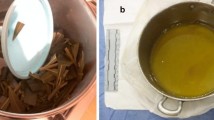Summary
Clinical, macroscopic and histological changes caused by di-n-octyl-tin-bis-[2-ethyl-hexyl-mercaptoacetate], di-n-octyl-tin-bis-[dodecyl-mercaptide], di-n-octyl-tin-bis-[butyl-mercaptoacetate] and mono-n-octyl-tin-tris-[2-ethyl-hexyl-mercaptoacetate] in white mice were studied. The compounds tested were administered to strain “H” white mice by means of a stomach tube as a single dose of 4,000 mg/kg body weight.
Signs of acute intoxication were observed clinically and in the macroscopic findings of all animals in the experimental groups. They were, however, of different degree in the individual groups. A prominent histological finding was steatosis of hepatocytes, which was found to be of varying distribution and intensity in the individual experimental groups. In some of the animals, steatosis of renal cortical tubular epithelium was also observed. Neither clinical nor morphological changes were noted in any of the animals of either control group.
The oral LD50 values of these compounds for white mice were determined in preliminary experiments.
Zusammenfassung
In unserem Versuch wurde die toxische Wirkung von reinein Di-n-octylzinn-bis-[2-ethyl-hexyl-mercaptoacetate], Di-n-octylzinn-bis-[dodecyl-mercaptide], Di-n-octylzinn-bis-[butyl-meroaptoacetate] und Mono-n-octylzinn-tris-[2-ethyl-hexyl-mercaptoacetate] an weißen Mäusen klinisch, makroskopisch und histologisch verfolgt.
Diese Verbindungen wurden in Oleum helianthi gelöst und den nüchternen Mäusen mittels Magensonde in einer Menge von 4000 mg/kg des Körpergewichts der Mäuse einmalig appliziert.
Die Tiere wurden 24 Std klinisch beobachtet, dann durch Decapitation getötet, seziert und die Organe histologisch verarbeitet. Die Präparate wurden mit Hämatoxylin-Eosin gefärbt. Von Leber und Nieren wurden daneben auch die Gefrierschnitte angefertigt und mit „Oil red“ (Bayer-Leverkusen; Partie A4592) gefärbt.
Im klinischen Bild wurden bei den Tieren aller experimentellen Gruppen Anzeichen einer akuten Intoxikation, selbstverständlich in den einzelnen Gruppen in unterschiedlicher Schwere beobachtet.
Im makroskopischen Befund aller Versuchstiere wurden die Veränderungen an den Organen des Verdauungstraktes, der Leber, der Milz und der Nieren festgestellt.
Im histologischen Befund bei den Tieren aller experimentellen Gruppen wurde eine Steatose der Hepatocyten in unterschiedlicher Schwere und Lokalisation und bei den Tieren einiger experimentellen Gruppen auch eine Steatose des Tubulus-Epithels in den Nieren festgestellt. In der Milz aller Versuchstiere wurden die Zeichen der Aktivation in den Keimzentren der Follikel gefunden.
Bei allen Tieren der zwei Kontrollgruppen, denen nur Oleum helianthi oder Wasser verabfolgt wurden, wurden Veränderungen weder im klinischen noch im morphologischen Bild gefunden.
Im vorläufigen Versuch wurden auch die LD50-Werte der geprüften Verbindungen für weiße Mäuse ermittelt; der LD50-Versuch wurde 48 Std nach der Applikation der Stoffe durch Magensonde beurteilt.
Similar content being viewed by others
References
Ascher, K. R. S., Nissim, S.: Organotin compounds and their potential use in insect control. World Rev. Pest. Control.3, 188–211 (1964).
Barnes, J. M., Magos, L.: The toxicology of organometallic compounds. Organometal. Chem. Rev.3, 137–150 (1968).
—, Stoner, H. B.: Toxic properties of some dialkyl and trialkyl tin salts. Brit. J. industr. Med.15, 15–22 (1958).
— —: The toxicology of tin compounds. Pharmacol. Rev.11, 211–231 (1959).
Franzen, V., Neubert, G.: Probleme der Stabilisierung von Hart-PVC für Verpackungsmittel. Chem.-Ztg./Chem. Apparatur89, 801–807 (1965).
— —: Beurteilung von Zinnstabilisatoren in PVC-Verpackungsmaterial für Lebensmittel. Techn. Rundschau (Bern)35, 13–16 (1964).
Klimmer, O. R.: Die Anwendung von Organozinn-Verbindungen in experimentelltoxikologischer Sicht. Arzneimittel-Forsch. (Drug Res.)19, 934–939 (1969).
—, Nebel, I. U.: Experimentelle Untersuchungen zur Frage der Toxizität einiger Stabilisatoren in Kunststoffen aus Polyvinylchlorid. Arzneimittel-Forsch. (Drug Res.)10, 44–48 (1960).
Patty, F. A.: Industrial hygiene and toxicology, vol. II, Toxicology. New York-London: Interscience Publishers 1963.
Roth, Z.: Grafická probitová methoda výpočtu LD50 a relativní toxicity. Cs. Fysiol.5, 408–422 (1961).
Author information
Authors and Affiliations
Additional information
The biological experiments were carried out in a subdivision of the Institute of Hygiene, i. e. Unit for Food Hygiene headed by Assoc. Prof. M. Polster.
Rights and permissions
About this article
Cite this article
Pelikan, Z., Černý, E. The toxic effects of some di- and mono-n-octyl-tin compounds on white mice. Arch. Toxikol. 26, 196–202 (1970). https://doi.org/10.1007/BF00578040
Received:
Issue Date:
DOI: https://doi.org/10.1007/BF00578040
Key-words
- Di-n-octyl-tin-bis-[2-ethyl-hexyl-mercaptoacetate]
- Di-n-octyl-tin-bis-[dodecyl-mercaptide]
- Di-n-octyl-tin-bis-[butyl-mercaptoacetate]
- Mono-n-octyl-tin-tris-[2-ethyl-hexyl-mercaptoacetate] = Organotin Compounds




